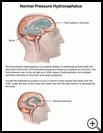
Normal Pressure Hydrocephalus
________________________________________________________________________
KEY POINTS
- Hydrocephalus is a buildup of fluid in the brain. The fluid is called cerebrospinal fluid (CSF). It is made in the brain and protects your brain and spinal cord.
- Normal pressure hydrocephalus is an ongoing (chronic) condition, but with treatment, most people can lead a normal life. Usually the treatment is surgery to put in a shunt.
- If you have had a shunt put in, it is very important that you follow the instructions for checking in with the surgeon to prevent problems with infection or blockage.
________________________________________________________________________
What is normal pressure hydrocephalus?
Hydrocephalus means “water on the brain” and is a buildup of fluid in the brain. The fluid is called cerebrospinal fluid (CSF). It is made in the brain and protects your brain and spinal cord. It also helps keep the right balance of nutrients in your nervous system. Normally, as new fluid is made, the old fluid is absorbed into your bloodstream.
If you have normal pressure hydrocephalus (NPH), CSF slowly builds up inside your brain. The fluid pressure may not be as high as in other types of hydrocephalus, but enlarged ventricles still cause symptoms and put pressure on the brain. Small increases in CSF do not cause problems. Bigger increases may cause problems with walking or memory.
What is the cause?
NPH may happen because your body may not absorb the CSF properly. It is not known why this fluid buildup happens. Sometimes brain injury or surgery can cause NPH. It may also be caused by tumors, infection, or blood vessels in the brain that are bleeding or bulging. NPH is most common in adults over the age of 60.
What are the symptoms?
NPH can cause many different symptoms, or may not cause any symptoms at first. The 3 most common symptoms are:
- Trouble walking. This is often the first symptom of NPH. You may feel mildly off balance, or you may not be able to stand or walk at all. Your walking stride may be short, slow, and shuffling. You may walk with your feet spread wide apart. You may have trouble picking up your feet. This can make it hard to go up and down stairs and curbs, and can cause you to fall.
- Memory problems. You may lose interest in daily activities, be forgetful, have trouble dealing with daily tasks, or have short-term memory loss.
- Loss of bladder control. You may feel the need to urinate more often than usual or have strong, urgent needs to urinate. Sometimes people with NPH need to urinate as often as every 1 to 2 hours. The urge to urinate is sometimes so strong that it cannot be held back and urine may leak.
How is it diagnosed?
Your healthcare provider will ask about your symptoms and medical history and examine you. There are no simple tests for NPH. If you have 2 or all 3 of the major symptoms described above, you may have tests such as:
- CT scan, which uses X-rays and a computer to show detailed pictures of the brain
- MRI scan, which uses a strong magnetic field and radio waves to show detailed pictures of the brain
- Neurologic exam, which is testing to check your strength, sensation, balance, reflexes, thinking, and memory
- Lumbar puncture, also called a spinal tap, which uses a needle to get a sample of fluid from the area around your spinal cord
How is it treated?
NPH is an ongoing (chronic) condition, but with treatment, most people can lead a normal life. Usually the treatment is surgery to put in a shunt. The shunt is made up of a tube and a valve. When fluid builds up in the brain, a one-way valve in the shunt opens, and the excess fluid drains away from the brain. The most common type of shunt uses tubing that runs down from your skull under the skin of your neck and chest. It ends in your belly. Fluid can be easily absorbed by the belly and does not cause any problems. This reduces the fluid and the pressure in the brain.
Sometimes NPH can be treated with other types of surgery that don’t use a shunt.
Symptoms may get worse without treatment and may lead to death.
How can I take care of myself?
How you take care of yourself depends on what types of problems the NPH is causing and what kind of treatment you need. For example, if you have lots of walking and memory problems, you may need to live in a protective place with family or caregivers to help you. If you have had a shunt put in, it is very important that you follow the instructions for checking in with the surgeon to prevent problems with infection or blockage.
Follow the full course of treatment prescribed by your healthcare provider. Ask your provider:
- How and when you will get your test results
- How long it will take to recover
- If there are activities you should avoid and when you can return to your normal activities
- How to take care of yourself at home
- What symptoms or problems you should watch for and what to do if you have them
Make sure you know when you should come back for a checkup.

